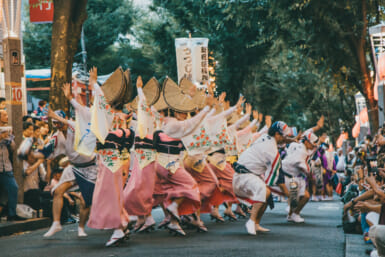by Tanya Korinfsky
Visiting a Japanese home
Many foreigners, even ones who have resided in these fair islands for aeons of time, complain that they have rarely, if ever, been invited to a Japanese home. There are several reasons for this.
To the Japanese, his home is truly his castle — a private domain that symbolizes the separateness between inner and outer, between family and non-family, between “us” and “them.” Generally speaking, outsiders are not admitted to the family circle. There are, of course, exceptions: when a teacher visits, or an old class mate. But the average Japanese does not go around casually and freely dispensing invitations to his home.
Apart from the wish of most Japanese to keep this inner sanctum inviolate are other more practical reasons. For one thing, if there is a visitor to the house, then he must be treated with all the ceremony and respect befitting such an occasion. The Japanese do not take this lightly.
Therefore, depending on the occasion and the ranking of the guest, special preparations that might range from buying the right seasonal cakes and preparing the right quality ocha (green tea) to requesting a caterer to see to it that the appropriate dishes are delivered to the house at a certain hour have to be undertaken. Needless to say, the right amount of money must be spent, too — any obvious budget-cutting strategies, if detected, could result in social disaster.
Then, the average Japanese is rather sensitive about his living quarters. Although quite a few can now be found snickering about their “rabbit hutches,” this openness has yet to be extended to the realm of invitations to these “rabbit hutches.” Generally, Japanese people are very uncomfortable in having to reveal anything that smacks of frugality. Thus, if a colleague or a friend has been to a foreigner’s residence, he will usually be loathe to reciprocate in what are often cramped and inadequate quarters compared to Western standards.
Also, the thought of having to entertain guests, especially foreign ones, would throw a lot of Japanese housewives into a severe panic. First of all, it would mean spending days cleaning, for contrary to the gaijin notion that everything in Japan is spotless, a peep into many of these apartments and kitchens would have some foreigners running to the Health Department. Japanese housewives are not used to the art of entertaining, which makes their husbands even more wary about inviting people home in case there’s a foul up on the part of their wives.
When you arrive at the door, remove your coat or jacket before knocking. You should be ready to enter the inner sanctum without fussing and struggling with overcoats and scarves. You will probably be required to remove your shoes in the genkan (entranceway). Some thought to footwear should be given beforehand. Slip-on type shoes are preferable to laceups or any kind that require maneuvering in a bending-down position.
Once the shoes are off you will be led to the main room, where you should hand over your offerings. You will be required to sit with your back to the tokonoma (alcove), the traditional position for the guest. Comfortable but formal-looking clothes are appropriate.
If you are offered slippers when you enter the house, the rule is to wear them everywhere but on tatami (straw matting). Be extra careful not to come trotting out in the toilet slippers after you use the facilities.
Throughout the visit you will never be out of place or offend if you adopt a reserved attitude. No back-slapping, risque humor or familiar tone with the wife.
It’s hard to judge when is the right time to leave, so look for cues from your host. When you’ve covered most topics of conversation on a light basis and the questions have stopped coming is usually a good time.
Again, outer clothing should be put on outside the door.
A hand-written thank you note in a rather formal style is considered appropriate if you have been the recipient of Japanese hospitality in the person’s home. But even if you’ve managed to penetrate the thick castle walls, don’t be disappointed if there’s no repeat invitation or entreaties to “drop over.” This is not the Japanese style and you should be flattered that you were permitted an inside look even once.








